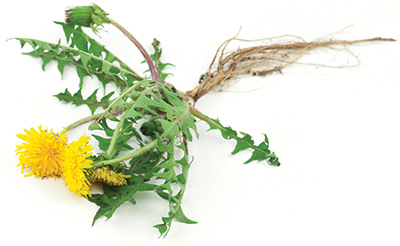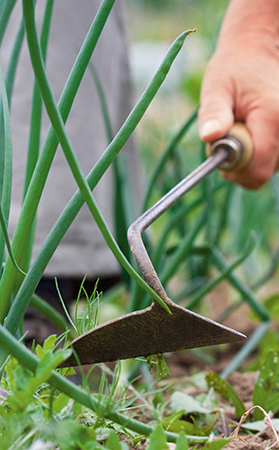
‘The best shade in the garden is the gardener’s own shadow,” counsels an ancient Chinese proverb, which is why our grandparents were out in the garden every day pulling weeds. But if you’re pressed for time, here are a few preventive measures you can try to keep botanical invaders at bay.
Weeds are plants that grow and reproduce quickly and easily but aren’t welcome in the garden because they edge out the more delicate flora and make the garden beds look untidy. However, if you take note of which weeds thrive you will be able to evaluate the composition of the soil, while their roots may ventilate the soil and enrich it with nutrients. Certain weeds serve as the basic ingredient in liquid fertilizers or compounds that are used to prevent and combat garden pests and diseases, while herbs such as dandelion, dock and sorrel are useful for their medicinal properties.
DIG OUT THE TAP ROOTS OF DANDELIONS WITH a trowel.
• Privet (Ligustrum spp.) has taken hold in many gardens and open spaces, as its berries are rapidly spread by birds. Its creamy-white sprays of flowers, which appear in spring, are also a major irritant for hayfever sufferers. Cut the tree off at ground level and spray the stump with glyphosate within 30 seconds. Repeat spray, if necessary, and remove any seedlings that come up.
• Wandering jew forms a dense ground cover, especially in damp, shady spots. Every piece of stem and root will regrow, so you need to be vigilant. Rake or roll up large areas, then go back over the area picking up any pieces left. Continue checking the area every couple of weeks. A thick layer of newspaper covered with at least a 2–4 inches (5–8 cm) layer of mulch can also inhibit growth.
• Onion weed grows in garden beds and lawns. It has light green, grass-like leaves, and in spring it sends up tall stems topped with white flowers. It is spread by the seed, and also when the bulb is disturbed. If you try to dig it up during active growth—spring and summer—the bulb instantly shatters, scattering tiny bulbils throughout the soil. The best time to try to remove it is in winter, when the bulb stays intact. Don’t try to sift the bulb from the soil. Instead remove and throw away the handful of soil within which the bulb is contained. Break off flowerheads whenever you see them and snap off the leaves. Herbicides are generally not effective.
• Lawn weeds can make a lawn look unsightly, but they are usually easily removed by digging them out by hand before they flower.
• Purslane seeds can persist in soil for years, so pull young seedlings or cultivate older plants with a sharp hoe on hot, sunny days. Gather and dry plants in the sun before composting them. Crowd future growth with dense plantings.
Make sure that weeds are pulled out regularly, as they spread quickly and rob other plants of nutrients.
• Weed on dry days after a rain when the soil is loose, allowing plants to be pulled up easily.
• In dry weather, let the weeds decompose at the edge of the bed.
• Weed again a few days after breaking up the soil of a bed. When you turn the soil, the seeds of weeds lying on the bottom may come to the top and start to shoot.
• Cut off flowerheads or seedpods before weeding or hoeing to prevent seeds from getting into the soil. Place seedheads in the trash, not the compost, to prevent them from germinating.
• Make short work of weeds growing in cracks and fissures between paving stones or on house walls by pouring boiling water on them.
• Pour salt on lawn weeds or sprinkle them with a solution of one part vinegar and one part water.

Be especially careful when hoeing weeds among single plants in a vegetable bed.
Chemical weed and pest killers are a bad idea. The substances they contain harm the environment and run the risk of damaging the soil so much that the plants you have nurtured die, too. With so many natural ways available to control weeds, there is no need to use them.
• Plants that rob weeds of light and nutrients through their own growth are an environmentally friendly way to control weeds. Ground cover plants are especially useful.
• Use dense-growing ground cover plants such as wild strawberries, periwinkles and violets for shady areas.
• Prevent weeds from growing in sunny beds by planting sedums, euphorbias and ground cover roses.
• Mulch between plants to prevent unwanted weeds from coming to the surface. For mulch, use freshly cut grass, wood chips, lucerne or sugar cane; in rock gardens you can also use gravel.
• Sow plants that nourish the soil. This also suppresses weeds and will later contribute to healthy growth in the flower bed.
• To prevent the growth of weeds in larger or inaccessible areas of the garden, cover thick layers of newspaper with mulch and cut crosses into the newspaper through which plants can emerge (or into which they can be planted).
GOOD TO KNOW 
The culinary side of weeds
Weeds are generally despised as invaders, to be pulled swiftly from the garden. But many of our ancestors would have seen them as food. Daisies, fat hen (goosefoot) and chickweed are tasty in salads. Ground elder and sorrel make a delicious soup or you can serve them as a vegetable. Young dandelion leaves are a surprisingly tasty treat mixed into salads and stir-fries.